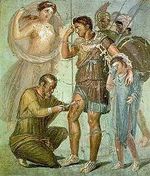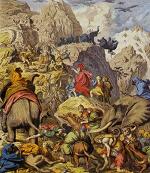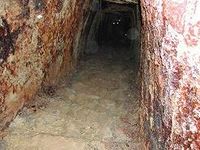Roman Times Quarterly/2008.1
THIS IS AN ARCHIVED PAGE DOCUMENTING THE INTERNAL HISTORY OF NOVA ROMA: LEARN MORE ABOUT ARCHIVED PAGES
Roman Times Quarterly ~ First Quarter 2761 a.U.c. (2008 CE)
Roman Medicine
by Marcus Audens
The tools of Roman Medicine which have come down to us through the efforts of archaeologists will give of some idea of the various techniques used for medical instances. Certainly one of the main resources of this information is brought to us from , “The House Of The Surgeon,” in the ancient city remains of Pompeii. In this place were recovered some of the medical instruments used, and from them we can gain a detailed insight into their use, and therefore into what might have been attempted in this Medical era.
One of the items undertaken would have been the surgical removal of permanent marks of disgrace, slave brandings and such which comes under the heading of plastic surgery. Another procedure which required a careful on the part of the surgeon was that of “trepanation.” This was the technique of boring a hole out of the patient’s skull in order to relieve pressure on the brain. This might be done because of a severe injury to the skull, or simply to relieve an interior pressure on the brain. In either case the the preliminary procedure was to remove the scalp from the area to be cut into and to pinch of the blood vessels. The instruments used were a circular cutter with very sharp teeth, and an instrument resembling a bow which was tightly wrapped around a shaft attached to the cutter. This was used to rotate the cutter assembly as it cut it's way through the bone of the skull.
Apparently this procedure was often used and on occasion quite successful as indicated by recovered skulls which had a similar hole in the skull and this hole being grown over with bone, indicating the the patient lived for some time after the operation. Doctors in the ancient times were not looked upon with a very high view of professional performance, as most of them were freedmen or slaves and many were little better than charlatans and quacks. Some were beauticians and hairdressers who supplied perfumes and cosmetics as well as doing minor surgeries in public in order to attract public awareness. There were some however, who did attempt to improve their medical knowledge, even though they still combined medical techniques together with religious ideas and procedures.
Greek medical information seemed to have been based mainly on scientific data, and observation. Roman medicine borrowed much from the Greek medical information , but combined it with mythical or religious views which would be known well in the local district. Hippocrates which is normally considered to be the “father” of modern medicine apparently separated philosophy, and the empirical study of medicine.
In the Roman world many religious views and prayers were accompanying the medical observations. Nearly all the Roman Gods had healing powers, and the beginning of the Roman involvement lay the God of Healing “Aesculapius”. Roman mythology indicates that the Greek God “Asklepios” who in the form of a snake left a ship in the Tiber River and took refuge on Tiber Island. Tiber Island became a refuge for Roman people who were sick, and finally a temple was built there to the Roman God of healing and ultimately a hospital was built there. A hospital still stands on Tiber Island in modern Rome. However in spite of the Roman refusal of theoretical treatment of the sick, generally good health was a blessing enjoyed by the Romans due to the availability of fresh water, baths and a generally improved hygiene due to the baths and the drainage of waste water.
(to be continued...)
Rome’s Pivotal Emperors: Augustus Caesar
by Marcus Audens
Augustus Caesar
- Born 63 BC
- Reigned 31 BC – 14 AD*Pivotal moment: In accepting his inheritance from Julius Caesar, Augustus turned the Republic into the empire.
There was very little in the family origins of Augustus to indicate his future rise to prominence. He was the son of a Senator, Gaius Octavius, whose name he shared, and Atia, the niece of Julius Caesar. In a codicil to his will Caesar adopted the young Gaius Octavius and made him his heir. History knows the young man as Octavian, but he never used this name preferring to portray himself as the new Caesar. The civil wars that followed Caesar’s assassination were part of Octavian’s inheritance.
By 30 BC he had eliminated his last rivals, Mark Antony and Cleopatra, and set about consolidating his power, greatly assisted by the fact that he controlled all the armies and had a direct access to the wealth of Egypt, which remained his own personal possession. His other assets were his shrewdness and patience. Many reforms were necessary, but he rarely imposed his will, and worked by legal means.
In order to oversee his initial reforms, he entered on his fourth consulship in 30 BC and held it every year until 23 BC. But the most important source of his power was that of the Tribunes which gave him the right of veto over any proposals. In 27 BC, he restored control of the Republic to the Senate, ostensibly reverting to the old order, with annually elected magistrates, the Senators sharing the responsibility for government, and no single individual with supreme power. But it was Republic in name only.
The reality was that Octavian emerged with the honorary title “Augustus” and the control, via his legates, of all provinces with armies. Augustus converted the republican citizen levy into a standing army, established regular pay and terms of service for soldiers, and a pension scheme for veterans. Gradually by his authority and influence he became the principal fount of law, he controlled state finance, foreign policy and religion, and he shaped Roman society as the republic, was transformed into the empire. In brief, he became the first emperor.
Hannibal: Carthaginian General and Political Leader
by Marcus Audens
Hannibal, Carthaginian General and Political Leader
- Born 347 BC
- Died 182 BC
- Enemy of Rome: Carthaginian general famed for bringing his army, including ele-phants over the Alps. He inflicted three huge defeats on Roman armies, including the largest ever at the Battle of Cannae in 216 BC.
Hannibal was appointed the commander of the forces of Carthage, in Spain, succeeding his father Hamilcar who held that position previously. In 221 BC, Hannibal took command of the army at a time when both Carthage and Rome were moving toward the second of the three Punic Wars (218 BC – 201 BC). The three Punic Wars collectively decided who would control the lands of the Western Mediterranean. Their conflict arose when both Rome and Carthage were vying for the news lands of Sicily, France and North Africa to plant colonies. Hannibal, not satisfied with continuing the conflict on the lands of Hispania, decided to attack Rome directly.
He started his campaign by overwhelming the Romans in Northern Hispania, and conquering those lands, and then decided to move his army across the Alps sure that the Romans would not expect such a tactical move. In the autumn of 218 BC, Hannibal moved 37 elephants, 50,000 infantry troops, and 9,000 cavalry across the mountains into Northern Italy. Once there he fought three major battles with the Roman Forces inflicting defeat at each battle:
- Trebbia in December of 218 BC;
- Trasimene in 217 BC (where 15,00 Romans were killed and another 10,000 captured);
- Cannae in 216 BC.
In the last battle at Cannae, Hannibal demonstrated a skill and mastery of using infantry and cavalry in combination, which he maneuvered to surround and destroy the very large Roman army of nearly 70,000 troops. The only survivors were approximately 14,500 who were taken captive. These figures reflect the largest number of casualties for any given battle, by any Western Army before or since that time. The Roman Republic’s morale was at it’s lowest ebb and things did not bode well in the future for the Romans.
However, even though Hannibal had been so successful in his Italian campaign, he did not receive a sufficient amount of reinforcement to continue to threaten Rome in Italy, even though his army survived there for over ten long years. The Romans scored victories outside of Italy and finally peace came in 201 BC, on terms that the Romans wanted. Later Hannibal became involved in politics, something that perhaps successful warriors should be very careful about, and finally his involvement in internal Carthaginian affairs became so unsuccessful that he was exiled in the year 195 BC. Following that by 12 years in 183 BC he committed suicide by poisoning rather than to allow himself to be handed over to his enemies, the Romans.
On Assignment: Augusta Treverorum (Trier)
by Marcus Audens
The following is a report on Augusta Treverorum (Trier) on SEXTILIS XI-XIII MMDCCLIX (11-13 August 2759) by a member of Nova Roma currently living in Germania
ASSIGNMENT: Augusta Treverorum (Trier) DATE: SEXTILIUS XI-XIII MMDCCLIX (11-13 Aug. 2759)
UNIT: LEGIO VI FERRATA, Cohor II, Vex. I
COMMANDER: Optio Bellator
LEGIO LEGATUS: Marcus Minucius Audens (acting) Legio VI Ferrata
REGION PROPRAETOR: Marcus Flavius Phillippus Conservatus
PURPOSE: To support LEG XV Primigenia and Auxiliaries during the Brot and Spiele (bread and games) and to maintain order throughout the gladiator fights.
Historical Background (no change): Established by the Assyrians in 2000 B.C.E. Archaeological finding date before Roman occupation possibly Celtic. Trier existed 1,300 years before Roma. Augusta Treverorum (Trier) was founded under Augustus in 16 B.C.E. Trier became a favored residence of several Roman emperors. The great city was surrounded by a four mile-long wall and had a population of 80,000 in the fourth century. It became known as the “second Rome.” In the third and fourth centuries Trier rivaled Alexandria and Roma as one of the richest, most effluent centers of the empire. Trier became the imperial capital of Constantine, the First Christian Imperator and he built a church during the fourth century. It is the oldest Cathedral in all of Germania. The Germanic Tribes destroyed the city in the 5th century and the once great city became a small town. There are many ruins that have still held strong up to today.
Buildings / Fortifications (no change): In addition to having the oldest Cathedral in all of Germany. Trier was the location of fa-mous Roman architecture to include the Imperial Baths constructed by Constantine, (Kaiserthermen) with a network of hot and cold water basins, drying rooms, dining halls, and forum, it covered an area of more than 400,000 square feet. The Romerbrucke, a Roman bridge built across the Moselle River, built almost two millennia ago; its mighty pillars still support the local traffic today.
The Amphitheatre, built in 100CE, has seating for 25,000 citizens. The 2nd century Porta Nigra (Black Gate), is about 100 feet high and 120 feet wide. It is the largest and most stunning city gate ever built in Europe and it was built to be an impressive symbol of Roman might and power. There was a stone wall that was four miles long and went around the whole city of Trier connected by the Porta Nigra and three other gates. The Aula Palatina, the palace and audience hall of Constantine I, Valentina, and Gratian, is second only to the Pantheon as the largest Roman public building the survive the centuries. There is also another Bath house nearby the Romerbrucke.
Assignment Report: Legio VI Ferrata cohor II, vex. I, arrived the 11th of Aug and set up camp near the vicus. LEGIO XV Primigenia, LEG Minervernia Pia Fidelas, COH III VIND, COH XXVI, a Gladiator troupe from Italy and LEG CAG (Cologne Augusta Germanica) had already arrived and began setting up fortifications and taking all necessary security measures in order to facilitate the large number of citizens coming to watch and participate in the events. The festival had vendors from all over Germania and Italia. There were metal workers, carpenters, sculptors, a master archer, an astronomer teaching the stars and the Julian date, cooks, jewelry makers, soap maker, A Pontifex, Fur Trader, wicker basket weavers, wool weavers, performers, musi-cians, pottery makers, and even a place to buy materials for the sacrifices to the gods.
Event Schedule: Legionaries set up camp in Vicus; Workshop for kids to begin learning skills as apprentices; Dinner and wine is served (authentic foods); Equites training and fighting begins on the exercise field (this involved a display of spear throwing, maneuvers, and swordsmanship)
XII Sextilis
- Legionary march from the Porta Nigra to the exercise field;
- Legionary training on the exercise field led by the Centurions (this included marching, facing movements, the proper maneuver of the testudo, soldier to soldier sword training, pilum throw, and interlocking shield drills);
- Workshop for continued skill building for children who learned to make jewelry, metal work-ing, clothing, Carpenter work, soap making, archery range, classes on the Julian date, and the Children’s favorite games);
- Equites training and fighting continued on the exercise field with jousting with spear and one of the Equites was knocked off his horse;
- Musicians took the stage to perform a delightful sound and excite the people (a Cornicularius took the stage and performed a song as well);
- The gladiator games took place in the amptheatre (I’m told that these are the finest gladia-tors in all land ruled by Roma). The first fight was of Greco wrestling, the second of Dimacheri, the third of Myrmillo vs. Secutor, fourth was an Ordinarii fight (Myrmillos and Hoplomachus), fifth was three vs. three (Myrmillos vs. Retiarius), last was a battle between Samnite and Pro-vocator. No gladiators were killed because they all fought very well, unfortunately four of the gladiators needed to see surgeons for wounds in the neck, back, thigh, and shoulders. Make no mistake these fights were no act.
- Mystic night (dancers, lights, mist, and other performers made a spectacle at night).
XIII Sextilis
- The final day schedule was the same as XII Sextilis.
- Gladiators -- Darius (Retiarius), An-thrax (Secutor), Marcus (Myrmillo), Rufus (Myrmillo), Lucius (Retiarius), Lea (Provocator), Hyrpus (Dimacheri), Caius (Myrmillo), Skorpius (Samnite), Metellus (Retiarius), Kratos (hoplomachus), Valori (Dimacheri), Valerius (Myrmillo).
Future Action / Recommendations: The festival was grand and exiting. I would recommend it to all the citizens to Roma. Future event to include. II IVN. --IV NOV. MMDCCLX (2 Jun-4 Nov 2760) Imperator Caesar Flavius Consantinus XI -- XIII SEXTILIS MMDCCLX (11-13 AUG 2760) Brot und Spiele (Bread and Games). Pictures may be viewed upon request.
Suppliers:
- Hetman Militaria
- http://www.Arsdimicandi.net
- http://www.timetrotter.com
- http://www.classis-germanica.de
- http://www.frisius-f.de
On Ancient Geography
by Marcus Audens
In ancient times the geography of the world was determined not only by actual surface exploration, but also by astronomy, philosophy, geometry, astrology and physics. Needless to say what the ancients came up with from their observations in all of the areas was a very interesting array of facts, and idea.
Plato (4th cent. B.C.) wrote about a world which was the center of a larger universe around which other heavenly bodies rotated. Aristotle who was a student in the Athenian Academy founded by Plato added to the information by referring to the curved shadow of the earth projected on the moon during a lunar eclipse. Herodotus believed that the earth was set around the Mediterranean Sea and items of topography were balanced by nature, such as the Nile River in the Southern region which was matched in the northern region by the Danube River, and outside the lands that were apparent to explorers and visionaries at this time there was a surrounding ocean.
Eudoxos of Cnidus who was a contemporary of Plato developed a theory of climate zones based on what angle of presentation the lands made to the rays of the sun. This theory was a little more sophisticated that the others of the period. Aristotle, seizing upon this theory, as a basis then postulated the idea of zones which allowed humans to live depending upon the average temperature of the zone, and thus originated the idea of of a temperate zone in which men could live comfortably, and a torrid zone in which men could not so live. The Great Library of Alexandria, had it’s school of scholars and became the world’s first scientific institute of a type.
It was here that the scholar Eratothenes determined the first accurate calculation of the earth’s circumference as 250,000 stadia (25,000 miles / 40,000 kilometers) which was inaccurate only by one / half of a percentage point. He was the author of a work in which he described five zones in the world enhancing upon Aristotle’s idea (one torrid zone, two temperate zones, and two zones which were frigid zones). He agreed with the view of the land masses, Europe, Asia, and Libya (Africa), and then developed for the first time lines of both longitude and latitude using irregular lines of spacing and was also the first to use an atlas grid system in mapping. His meridian line was set upon the city of Alexandria, and his prime latitude was a line drawn through the Pillars of Hercules.
A successor who was also the librarian at Alexandria was the first to develop a way to deal with the curved surface of a sphere could be laid on a flat surface. These were called projections and while effective in some ways were not perfect as they portrayed only one half of a globe or hemisphere and the central portion of the projection was either too small or too large in relation to the perimeter. Strabo is a Roman authority of geography (c.64 B.C. to 20 A.D.) and much of what has come down to us from the ancient’s view of geography is due to this author and geographer.
He authored a a great work on the subject by the name of “Geographica” a work which remains in the modern day almost totally intact. He was willing to use information put forward by those who preceded him in this area and he is well known for his study at Alexandria which gave rise to many of the ancients who studied this area of expertise. He was in agreement with Aristotle’s zone of habitability, as well as the believed existence of an ocean surrounding the then known world. Strabo was known to have traveled widely and as he stated in his writings, “Westward I have journeyed to Etruria (Italy) opposite Sardinia; toward the South from the Euxine (Black Sea) to the borders of Ethiopia.”
Another ancient geographer was Claudius Ptolemaeus (Ptolemy) who was present doing research work at the Library in Alexandria between the years A.D. 127 and A.D. 150. He authored a great work of astronomy, the “Almagest” which was for a very long period the basic and standard reference for the movement of stars, and planets across the heavens. He conceived the earth in much the same way as the older Aristotle had; that the earth was a single sphere which did not move, and around which all other heavenly bodies moved. His next work was the many volumes of something called the “Guide To Geography” in which he attempted to produce a map of the world which was correct in his period. In this work he detailed in six volumes the worlds first geographical gazetteer. In this work he utilized a set of grid lines called latitude and longitude.
However, accurate measurement was not possible for longitude because of the time factor requiring precision timekeeping, and there was also no way to measure latitude beyond an approximate determination. A large error was part of this work in that Ptolemy had accepted of the circumference of the world as provided by Posidonius rather than the more
(to be continued...)
Mines and Quarries: Laurium
by Marcus Audens
LAURIUM: One of the best known mining regions of the classical world was southeastern Attica, especially in the area of Mount Laurium (Laurion). It is here that there are the remains of an ancient Mycenean citadel at Velatouri. Pottery shards confirm the existence of a flourishing Mycenaean urban complex at nearby Thorikos. The discovery of fragments of litharge, the product of the cupellation of lead sulfide -- a refining process to separate the metal -- indicates that galena was being mined from ca. 1350 B.C. and possibly from as early as 1500 B.C.
Mining continued with few interruptions into the period of Roman occupation, until the slave revolt in 103 B.C. The mines at Laurium owed their existence to the simplicity of the geological formations of the region, that is, to the occurrence of lead, zinc, and silver deposits on the crystalline basement rocks. Three layers of limestone alternated with two of schist and contained veins of three principal minerals: argentiferous, pyretic galena and sphalerite.
The first mining at Thorikos was by pitting, digging holes as primitive shafts until ore was found. When the ore ran out the pit was abandoned. This technique was later replaced by digging mine passages (adits) into the hillsides. When miners were successful in discovering a vein, the shapeless exploratory opening was reduced to a small gallery of regular dimensions: otherwise it was abandoned.
The first contact at Laurium had been haphazardly exploited and surface lodes became less important as the need for silver increased. This inevitably led the Athenians to mine the deeper sulfide deposits. The loss of the Thracian silver mines to the Persians at the end of the sixth century B.C provided an added incentive.
A “third” contact was opened up and by 483 B.C. was producing 100 talents of silver a year. (There is no evidence regard the “second contact.” Most likely this line did not provide adequate economic returns and so was not mined.) The mines covered a large area, the richest being concentrated near Maroneia. Analysis of gold trace elements and lead isotope ratios in Athenian coinage distinguishes Attic from Thracian silver.
(to be continued...)
Visit us online at: http://www.novaroma.org/nr/Roman_Times_Quarterly






